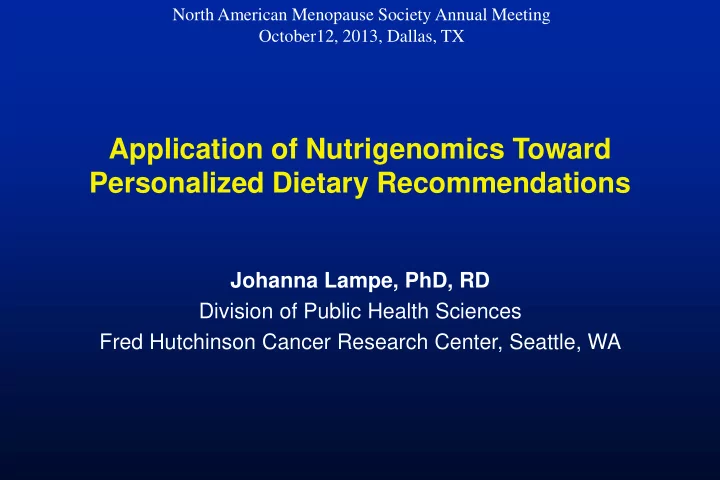

North American Menopause Society Annual Meeting October12, 2013, Dallas, TX Application of Nutrigenomics Toward Personalized Dietary Recommendations Johanna Lampe, PhD, RD Division of Public Health Sciences Fred Hutchinson Cancer Research Center, Seattle, WA
Questions How can genetic variation influence response to diet? How can “omic” approaches be incorporated into the study of gene-diet interactions? How do we move forward to personalized dietary recommendations, now and in the future?
Nutrigenomics: Study of the interactions between genes and diet. Study of how genetic variation influences response to diet. GENOME Health & EPIGENOME DIET Disease Risk MICROBIOME Gut bacterial genome
Nutrigenomic Approaches: Analysis of Gene-Diet Interactions Epi/genomics Susceptibility (e.g., genetic variation) Transcriptomics Transcription Translation DNA mRNA Protein Protein Function Proteomics e.g., enzyme activity Substrate Product Metabolomics Down-stream Effects
The human diet is complex. 1000s of compounds Variety of methods of food preparation Structure and particle size Bioavailability to host
How can genetic variation influence response to diet? Food preference Food tolerance Absorption Transport Metabolism Effect in target tissue Lampe and Potter, in Gene-Environment Interactions (Costa and Eaton, eds), 2006
Metabolism: NAT2 Polymorphism Modifies Dietary- Induced DNA Damage in Colorectal Mucosa 2-day vegetarian diet vs 2-day grilled meat diet Measured DNA strand breaks in epithelial cells extracted from stool samples NAT2 Genotype Vegetarian 80 baseline * Tail moment 60 High-meat 40 20 0 NAT2 rapid NAT2 slow Kiss et al, Eur J Cancer Prev , 9:429, 2000
Increased Urinary Mutagenicity with Fried Red Meat Intake in Individuals with UGT1A1*28 Unhydrolyzed Urinary Mutagenicity and Cooked Meat: • 2-week controlled Stratified by UGT1A1 Genotype feeding study in 60 Increase in urinary mutagenicity per 10 g meat intake/day subjects • Fed red meat cooked at UGT1A1 Point 95% CI P-value genotype estimate 250°C • Mutagenicity of urine 6/6 747 -1166-2660 0.450 tested using Salmonella YG1024 (+S9) 6/7 or 7/7 4062 1623-6511 0.003 P for interaction between UGT1A1 and meat intake = 0.04 Peters et al, Environ. Mol. Mutagenesis , 2004
Metabolism of Chemopreventive Phytochemicals: Isothiocyanates Conjugated by Glutathione S -Transferases and Excreted in Urine g -GT GST CG AT ITC- ITC ITC- ITC- ITC- N -acetylcysteine glutathione cysteine- cysteine + glycine GSH Dithiocarbamates, excreted in urine
Impact of GSTM1 Polymorphism on Sulforaphane Pharmacokinetics GSTM1-null subjects had: 120 Urinary excretion (%) Greater rate of 100 urinary excretion of 80 sulforaphane in first 60 6 h 40 Higher % GSTM1-null 20 GSTM1+ sulforaphane 0 excretion over 24 h 0 4 8 12 16 20 24 Time (h) Gasper et al, Am J Clin Nutr , 2005
Integrating Genomics and Metabolomics: A Cross-Sectional Study Epi/genomics 284 men GWA study data with serum metabolomics-based quantitation of 363 Metabolomics metabolites. Reported associations of frequent SNP with differences in the metabolic homoeostasis, explaining up to 12% of observed variance. Gieger C et al, PLoS Genet , 2008.
Genotypes and Metabotypes: Endogenous Metabolite-SNP Interactions • Associations of frequent SNP with differences in the metabolic homoeostasis explained up to 12% of observed variance. • Using ratios of certain metabolite concentrations as proxy for enzymatic activity, explained up to 28% of the variance (P-values 10 - 16 – 10 -21 ). • Identified 4 variants in genes coding for lipid metabolism enzymes (FADS1, LIPC, SCAD and MCAD), where corresponding metabolic phenotype matched pathways in which these enzymes are active. Gieger C et al, PLoS Genet , 2008.
Genetically Determined Metabotypes: A GWA study of metabolic traits in human urine • Designed to investigate the detoxification capacity of human body. • Tested for associations between 59 metabolites in urine from 862 male participants in the SHIP study and replicated the results in independent samples. • Reported 5 loci with joint P values of association from 3.2 × 10 −19 to 2.1 × 10 −182 . Variants at 3 loci previously linked with important clinical outcomes: SLC7A9 is a risk locus for chronic kidney disease, NAT2 for coronary artery disease and genotype- Suhre et al, Nat Genet 43: 565 – 69, 2011. dependent response to drug toxicity,
Gut microbial variation: Metabolism of soy isoflavone daidzein HO O HO O O O OH OH Urinary Equol Excretion Daidzein Dihydrodaidzein 30-50% of nmol/d individuals HO O 10000 produce OH OH Cis / Trans -isoflavan-4-ol 100 HO OH HO O O OH 1 OH O -Desmethylangolensin Equol equol
INTERVENTION: Lymphocyte Gene Expression Differentially Induced in Equol-Producing and Nonproducing Women 30 postmenopausal women ~900 mg isoflavones for 84 d Gene expression array of peripheral lymphocytes 27 genes changed with isoflavones Stronger effect on estrogen- responsive genes in equol producers than nonproducers. Niculescu et al, J Nutr Biochem 18:380, 2007.
Gut Microbiome Phenotypes: Enterotypes Arumugam et al, Nature , 2011
View to the Future Focusing efforts in areas where evidence is suggestive, but inconclusive, most likely to result in findings that can advance scientific knowledge or change public health practice Understand the mechanisms Reconcile the heterogeneity Application of genomic and systems approaches to understand: Biologic pathways and mechanisms Complexity of effects of dietary patterns Behavior
Ultimate Goal of Metabotyping • Develop a novel approach to personalized health care based on a combination of genotyping and metabolic characterization. • Identify genetically determined metabotypes that can subscribe the risk for a certain medical phenotype, the response to a given drug treatment, or the reaction to a nutritional intervention or environmental challenge. • Characterize microbial modification of effects of diet. Gieger et al, PLoS Genet , 2008 Lampe et al, Proc Nutr Soc , 2013
SNP arrays What do we need to get there? Sufficiently sensitive technologies to Transcriptomics detect small, but physiologically relevant, differences or changes in response to diet. Data analysis, visualization, and Proteomics annotation methods. Ability to integrate the various omics platforms in a systematic fashion. Metabolomics Characterization of phenotypes.
Is there potential for personalized, or more precise, individual dietary recommendations? Yes, but still have to: Establish the relevant parameters Integrate the omics data Don’t lose sight of the broader public health messages that can have the greatest impact on the largest number of people
Recommend
More recommend